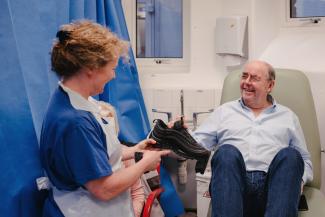We invest around £6.5 million into new diabetes research every single year. This research helps us to learn more about diabetes, prevent its complications and change lives. Here we dive into a brand-new project that’s exploring ways to protect people living with diabetes from foot ulcers.

This research is being carried out by one our amazing early career researchers, Dr Petra Jones, a Senior Research Associate at University Hospitals of Leicester NHS Trust. With our funding, Petra is putting the existing footwear fit guidelines to the test, to find those that could best help to reduce or prevent diabetes-related foot ulcers.
Diabetic foot ulcers are patches of broken skin on the foot that are slow to heal due to the damage caused to nerves and blood vessels in the feet by high blood sugars. Ill-fitting footwear can increase the risk of an ulcer developing. And research suggests that over 65% of people may be wearing footwear that is not right for them. But the different guidelines on what makes a good fitting shoe are inconsistent. Petra’s project hopes to change this.
To find out how Petra found herself in the world of diabetes footcare, we asked her about journey into research.
“It all started with a conversation. I had a work colleague with diabetes who had problems with his feet and was interested as he talked about his experiences. I felt technology such as pressure or temperature monitoring should be doing more to help prevent ulcers.”
In her current Diabetes UK-funded project, Petra is inviting 60 people with diabetes and foot nerve damage to have the nerve damage in their feet assessed. Then, while wearing shoes they wear most often, and later standardised footwear, the participants will have the level of pressure on their feet measured. Using this information, alongside measurements of their footwear and feet, Petra will assess if the footwear is correctly fitting. This will allow her to find out which shoe fitting guidelines are most helpful. Better guidance could help to protect the feet of people with diabetes and prevent the potentially devastating complications that foot ulcers can cause.
The next steps
“I enjoy my work as for every answer we find, there are more questions that need answering! If we find that a particular recommended footwear fit guideline is associated with lower in-shoe pressures or lower temperatures, the next research question is which measurement devices are most reliable to assess that fit? By answering these questions, we can try to improve guidance on footwear fit and identify the best ways to assess it.
“In the future, I’d like to see an ulcer prevention service offering 3D foot scanning to provide custom footwear, and in-shoe pressure measurement to offload pressures that pose an increased risk of ulceration using insoles, orthotics and custom footwear.”
Petra is keen to present these new technologies to people with diabetes, involving them in the process and asking them about what changes they’d like to see.
Why your support is so important
You can find out more about all the research projects we fund and how your support is helping our scientists to pave the way in transforming the lives of people with diabetes, as Petra explains.
“I’m so very grateful to all supporters of Diabetes UK. We couldn’t do what we do without you. I also learn a great deal from the people with diabetes who give up their time to talk to me, and tell me about their experiences with footwear, ulcers and sensation in their feet.”
